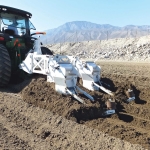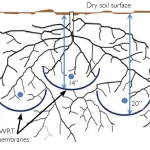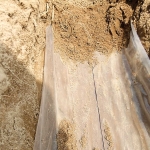An exotic idea—hatched 50 years ago in plant science and agricultural engineering laboratories at Michigan State University and stalled by odd events in the deserts of Libya—has been resurrected and is starting to bear fruit.
It could greatly change how crops, including tree fruits, are grown on sandy soil and/or in desert conditions. It dramatically changes how efficiently crops use water and the nutrients that water carries.
The system, called Subsurface Water Retention Technology (SWRT), is being developed by Dr. Alvin Smucker, a Michigan State University professor of soil biophysics.
Here’s how it works:
Sheets of polyethylene film are installed about 24 to 27 inches underground using a special machine.
The film is installed in a trough shape that holds water, whether applied by irrigation or natural rainfall. The barrier stops the natural downward percolation that results in losses of valuable water and fertilizer from the root zone and into groundwater.
If there is too much water, it overflows the contoured trough so that roots can’t be flooded and drowned. The U-shaped troughs are installed side by side, at slightly different depths, so that roots can explore around and below the barriers.
Smucker was a graduate student at Michigan State University in the 1960s, working with Professors A. Earl Erickson and Clarence M. Hansen, when they developed a machine to lay a thin asphalt layer under sandy soils to create a barrier to downward water percolation. It worked.
Smucker says farmers who had small test plots on their farms back then may not even know why, today, 50 years later, the grass is greener and the crops yield better there. He says he can find the plots using Google Earth and see, from the lush condition of the vegetation, that these barriers are still at work.
The machine and the process was described in glowing terms in the September 17, 1966, issue of Michigan Farmer magazine (co-written by the writer of this article). Entitled “Asphalt under the Earth,” the article estimated that the process would make farmable land out of 10 million acres in Michigan alone.
One machine
So what happened? Why didn’t this become standard industry practice?
As Smucker tells it, the researchers built just one machine. The concept was tested in several countries, but in most places test plots were installed by hand. Smucker tells of working for three weeks with 270 Chinese workers in Taiwan to bury a thin layer of asphalt to test the concept for growing rice and sugar cane.
The team also decided to test the concept in Libya, a desert country in North Africa. They sent their only machine there. That was 1969, the year a coup led by Muammar al-Gaddafi overthrew the government. To reduce foreign imperial influence in his country, he nationalized the oil industry. He also sequestered their machine.
“It all kind of came to a big, rapid stop,” Smucker said. “We decided we’d done enough research to prove the concept and, if it was worth adopting, it would be.”
But it wasn’t adopted.
After 1969, Smucker turned his attention to other forms of soil and water conservation—notably working in the development of no-till farming.
Idea reborn
However, 41 years later, still liking the basic idea of installing barriers under soil to stop the downward flow of water and nutrients, Smucker, now a professor himself, resurrected the concept. This time, he said, he’s mustering the support needed to make it work in the real world.
The machine has been patented and is being manufactured in commercial quantities. A company has been formed, called SWRT Solutions. The university’s technology office is involved.
MSU is looking to partner with people who understand the business—like those who use similar machinery to install drain tile in farmland and those who install irrigation systems—to take on a new line of business installing subsurface water-retaining membranes.
“A strategic global initiative is being developed with partners from foundations, the private sector, academic institutions, international development organizations, and selected host country governments,” Smucker wrote in a white paper on SWRT. “Its goal is to establish national and international consortia for prototyping, field testing, pilot technology transfer, and large scale implementation in the United States, Australia, the Middle East, Africa, China, Southeast Asia, and South America.
“Today’s new SWRT applications to sandy soils offer the potential to transform barren landscapes into sustainable plant production regions that transform lives and communities,” he wrote.
The potential market is huge. The United Nations’ Food and Agriculture Organization estimates that the technology could be applied globally to 5.3 billion acres that are now not producing food or fiber.
Not only are there millions of acres of arid and desert land, worldwide, that could be more effectively irrigated if the soil had a barrier to reduce water loss, but there are millions of acres of sandy soil in higher rainfall areas that could produce better if the soil would hold more water when it falls.
Smucker has tested the system in Michigan, where rainfall is good but seasonal, and crops on sandy soils, including in the fruit belt along Lake Michigan, wither and die in August. SWRT Solutions have also been installed in the drylands of west Texas, where cotton yields were increased nearly five-fold.
“Where highly permeable soils have prohibited the production of food, water retention membranes reduce quantities of supplemental irrigation and fertilizer protecting potable groundwater supplies and enable more efficient use and control of fertilizers and pesticides,” he says.
Low cost
Not only is the potential market large, but the cost is surprisingly low. Smucker says installation costs from $1,400 to $1,800 an acre, and the “fix” is virtually permanent unless someone desired to install a biodegradable film instead.
“The return on investment for the installation of these membranes, which improve the yields on a broad range of crops, is less than one year for vegetable crops,” Smucker said. “Plus, this is a zero-maintenance system with sustainable water-holding capacities up to 300 years. This could have a major impact on providing food and bio-based energy for the future.”
Yields in Michigan have been doubled, tripled, even quadrupled. Smucker has test plots in west Michigan’s fruit and vegetable production belt. He is beginning similar research with blueberries and working on designs that would apply it to tree fruits. The membranes could be installed in existing orchards or before new orchards are planted.
On irrigated plots, the barriers reduced the need for irrigation by about 50 percent by preventing water loss by percolation and increasing the water holding capacity of sandy soils. Another benefit is soil improvement. Crop residues on productive soils sequester carbon and increase soil organic matter.
Smucker is working with installations in other countries—including Israel, Iraq, Iran, Turkey, China, and Saudi Arabia. Near Baghdad in Iraq, he said, not only have they achieved higher yields with less water, but they have been able to reduce soil salinity by using salt-free water to irrigate roots in these SWRT membranes. After years of improper irrigation, much of the farmland around the Euphrates and Tigris Rivers has been abandoned because of high salt content.
Easier to use
The machine Smucker worked with in the 1960s was not easy to use, he said. “The asphalt had to be hot, 160˚F to 180˚F, and supplied by a tanker truck. It was a cationic solution.
A chisel six feet wide lifted the soil, hot asphalt was sprayed from behind the chisel, and ammonia gas was injected to solidify the asphalt immediately so the sand could settle back on top of it.”
In the Michigan Farmer article in 1966, the writers skirted around the hardening process—the asphalt-ammonia combination—which was then a secret and a key part of the patent.
Smucker thinks the time is right for the new technology. It could be a game changer in places like the western United States, where urban and industrial centers compete with farmers for scarce water supplies.
“There now is a long-term technology that controls optimal quantities of soil water, one of the world’s most finite critical natural resources,” Smucker wrote in one of his published papers. •









SWRT represents an innovative approach. Can you comment about the value the SWRT system may also provide for nutrient retention within sandy soils?
Does SWRT change the microbial population ? Are local beneficial microbes lost ?
[…] the rate of water percolation is the key to Subsurface Water Retention Technology. Alvin Smucker, a Michigan State University professor, has been working on the system, which not […]